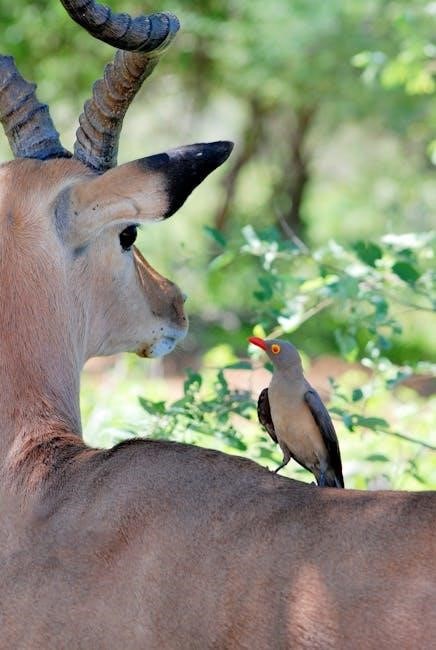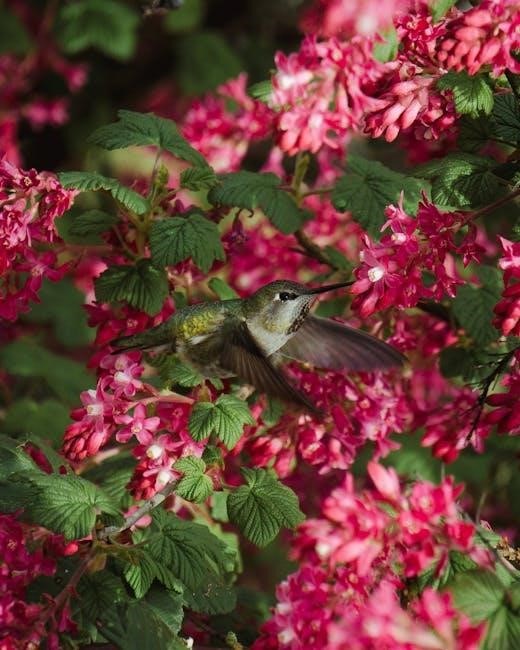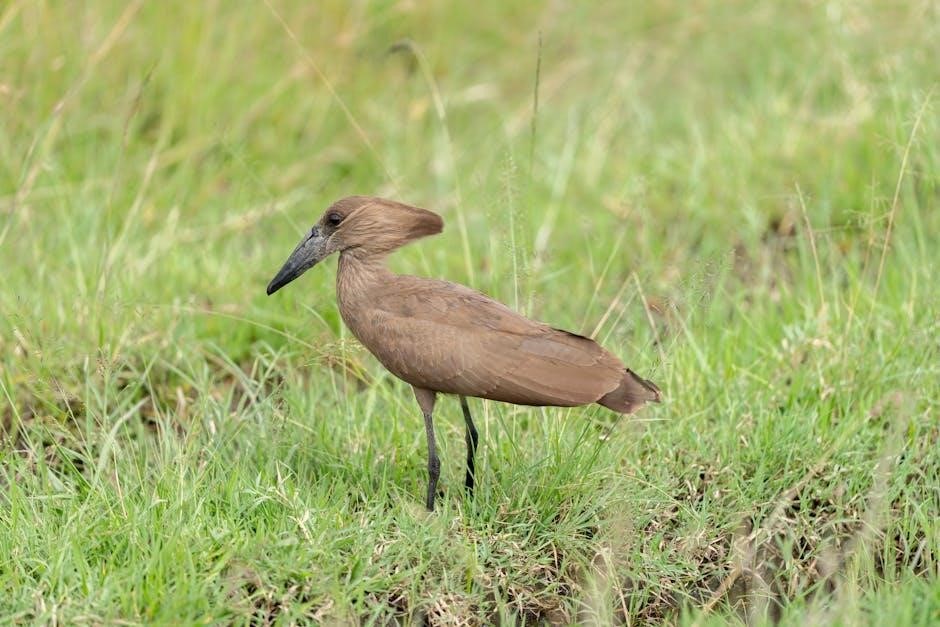Welcome to the guide on Oregon game bird regulations. This guide provides essential information on licensing, seasons, bag limits, and legal methods for a sustainable hunting experience.

Overview of Game Bird Hunting in Oregon
Oregon offers diverse opportunities for game bird hunting, attracting enthusiasts across the state. The region’s rich wildlife includes upland game birds like chukar, quail, and pheasant, as well as waterfowl such as ducks and geese. Hunting conditions vary by region, with eastern Oregon known for its prime upland bird habitats and western areas hosting abundant waterfowl. The Oregon Department of Fish and Wildlife (ODFW) manages these resources to ensure sustainable populations and fair access for hunters. Seasonal regulations, bag limits, and permits are designed to balance recreational hunting with conservation efforts. Hunters must familiarize themselves with specific rules for upland and waterfowl species to enjoy a successful and lawful experience. Proper planning and adherence to guidelines are essential for a safe and rewarding hunt in Oregon’s vast landscapes.
Licensing Requirements for Game Bird Hunting
A valid Oregon hunting license and, if required, a game bird permit are essential for hunting game birds in the state. Check-in and check-out rules apply.
Types of Hunting Licenses in Oregon
Oregon offers various hunting licenses tailored to different needs. Resident and non-resident licenses are available, with specific options for youth and senior hunters. A general hunting license covers most upland game birds, while specialized permits are required for waterfowl and certain species. Additionally, combination licenses bundle hunting and fishing privileges. Apprentice licenses are designed for newcomers to gain experience under mentor supervision. Some licenses, like the Upland Game Bird Permit, are mandatory for specific species. A Habitat Stamp is also required for hunters 18 and older to support wildlife conservation. Proper documentation and residency verification are necessary for license applications. Ensure the correct license type is obtained based on the target species and hunting location to comply with state regulations.
Application Process for Game Bird Licenses
To obtain a game bird license in Oregon, applicants must follow a structured process. Begin by visiting the Oregon Department of Fish and Wildlife (ODFW) website to access the online licensing system. Create an account or log in if already registered. Fill out the application form, ensuring all personal and residency details are accurate. Required documents, such as proof of residency and hunter education certification (for first-time applicants), must be uploaded. Payment for the license and any additional permits, like the Habitat Stamp, can be made securely online. Once submitted, the license is typically issued immediately and can be printed or downloaded. Licenses are also available at ODFW offices or licensed vendors statewide. Ensure all steps are completed before the hunting season begins to avoid delays. Properly following the application process ensures compliance with Oregon’s game bird regulations.
Cost of Licenses and Permits
The cost of game bird licenses and permits in Oregon varies based on residency and license type. Resident hunters benefit from lower fees, while non-resident licenses are priced higher to reflect access to Oregon’s natural resources. A standard resident game bird license typically costs around $33, while a non-resident license is approximately $136. Additional permits, such as the Harvest Information Program (HIP) validation, are required for waterfowl hunting and are included in the licensing fee. A Habitat Stamp, supporting conservation efforts, is also mandatory for all hunters and costs $10. Youth hunters (ages 12–17) pay reduced fees, and seniors (65+) may qualify for discounted licenses. Prices are subject to change annually, so it’s essential to check the Oregon Department of Fish and Wildlife (ODFW) website for the most current information before purchasing.

Hunting Seasons and Dates
Oregon’s game bird hunting seasons vary by species, with most upland game bird seasons starting in September and waterfowl seasons beginning in October. Exact dates and species-specific regulations are published annually by the Oregon Department of Fish and Wildlife to ensure sustainable hunting practices and compliance with federal guidelines. Hunters must check the official ODFW website for precise season start and end dates, as they are subject to change based on conservation needs and migratory patterns. Properly following these dates is crucial for maintaining healthy wildlife populations and ensuring a successful hunting experience for all participants.
Upland Game Bird Seasons
Oregon’s upland game bird seasons typically begin in September and run through January, offering opportunities to hunt species like chukar, quail, and pheasant. Specific start and end dates vary by species and region, with detailed information available in the annual Oregon Game Bird Regulations guide. Hunters should note that some areas may require special permits for access. Bag limits are set to ensure sustainable populations, with most species allowing 2-4 birds per day; The Oregon Department of Fish and Wildlife (ODFW) updates season dates and regulations annually, so hunters must consult the latest guide before heading into the field. Additionally, regional variations in season timing accommodate different habitat conditions and species migration patterns, ensuring balanced and ethical hunting practices statewide.
Waterfowl Hunting Seasons
Oregon’s waterfowl hunting seasons typically begin in October and run through January, with exact dates varying by zone and species. The state is divided into zones, each with specific season frameworks for ducks, geese, and other waterfowl. Hunters should consult the annual Oregon Game Bird Regulations guide for precise start and end dates, as these can change annually. Daily bag limits for waterfowl are generally five birds, with species-specific restrictions. Special permits may be required for certain species, such as swans or brant. The Oregon Department of Fish and Wildlife (ODFW) also offers youth hunting days, providing young hunters with exclusive opportunities. Additionally, some areas may have limited access or require special permits, so it’s crucial to review the regulations before heading out. Always check for updates to ensure compliance with current rules and conservation efforts.
Special Permits for Game Birds
Special permits are required for hunting certain game birds in Oregon, such as swans, brant, and some species of geese. These permits are issued to ensure sustainable hunting practices and protect vulnerable populations. Hunters must apply separately for these permits, often through a limited draw system. Some permits may require additional fees or documentation. For example, hunting swans or brant typically requires a special permit due to their conservation status. Youth hunters may also have opportunities to participate in special permit-only hunts. Always check the Oregon Game Bird Regulations guide for specific requirements and application deadlines. These permits help manage harvest levels and maintain healthy bird populations for future generations of hunters.
Bag Limits and Possession
Bag limits and possession regulations for game birds in Oregon vary by species, ensuring sustainable hunting practices and conservation. Upland game birds and waterfowl have specific daily limits and possession caps to maintain healthy populations.
Bag Limits for Upland Game Birds
Oregon’s bag limits for upland game birds are designed to ensure sustainable hunting while providing opportunities for hunters. The daily limit for chukar is 8 birds, while the possession limit is 16. Similarly, quail have a daily limit of 10 birds and a possession limit of 20. These limits apply to all upland game bird species unless specified otherwise. Youth hunters under 18 years old have reduced limits, encouraging participation while maintaining conservation goals. Seasonal adjustments may occur based on population surveys, ensuring the long-term health of bird populations. Hunters are required to keep harvested birds in a condition that allows species identification until they reach their final destination. Adhering to these limits is crucial for maintaining Oregon’s rich upland game bird traditions and ecosystems.
Bag Limits for Waterfowl
Oregon’s waterfowl bag limits are structured to balance hunting opportunities with conservation. The daily limit for ducks is 7 birds, with no more than 2 female mallards, 2 pintails, and 1 canvasback. Geese limits vary by species, with a daily limit of 4 dark geese (e.g., Canada geese) and 10 light geese (e.g., snow geese). Mergansers have a combined daily limit of 5 birds, with no more than 2 hooded mergansers. Possession limits are three times the daily limit for all waterfowl species. These regulations aim to protect vulnerable populations while ensuring sustainable hunting practices. Hunters must keep harvested birds in a condition that allows species identification until they are processed for consumption. Adhering to these limits helps maintain Oregon’s waterfowl populations for future generations.

Legal Hunting Methods and Equipment
Oregon permits shotguns with steel shot for waterfowl and lead shot for upland birds. Archery and muzzleloaders are allowed, but baiting and electronic calls are prohibited.
Firearms and Ammunition Restrictions
Oregon game bird hunting requires specific firearms and ammunition. Shotguns with a capacity of no more than three shells are allowed, and non-toxic shot (like steel) is mandatory for waterfowl. Lead shot is permitted for upland game birds. Rifles are restricted to small game, and handguns must be .22 caliber or smaller. Fully automatic weapons are prohibited. Hunters must ensure ammunition complies with environmental and safety regulations. Electronic calls and baiting are illegal, emphasizing fair chase practices. These restrictions aim to balance hunter success with wildlife conservation and public safety. Always verify local updates, as regulations can change seasonally. Adhering to these rules ensures sustainable hunting practices and protects Oregon’s wildlife for future generations.

Archery and Muzzleloader Regulations
Archery and muzzleloader hunting in Oregon are subject to specific regulations. For archery, hunters must use bows with a minimum draw weight of 40 pounds, and broadheads must be at least 7/8 inches wide when fully open. Muzzleloaders must be .40 caliber or larger, using black powder or approved substitutes. Telescopic sights are allowed on muzzleloaders, but pre-charged pneumatic (PCP) air guns are prohibited. Hunters must complete an archery education course if born after 1975. Blaze orange requirements apply to archers during rifle seasons. Tree stands on public land must display the owner’s name and contact information. These regulations ensure fair chase and wildlife conservation, while maintaining safe and ethical hunting practices. Always check for seasonal updates to comply with Oregon’s evolving game bird regulations.
Adhering to Oregon’s game bird regulations ensures sustainable hunting practices and preserves wildlife for future generations. Always prioritize ethical hunting and conservation efforts to maintain healthy ecosystems and traditions.
Importance of Adhering to Regulations
Adhering to Oregon’s game bird regulations is crucial for preserving wildlife populations and ensuring sustainable hunting practices. These rules are designed to protect both game birds and their habitats, balancing ecological needs with hunting opportunities. By following regulations, hunters help maintain healthy ecosystems and ensure that future generations can enjoy similar privileges. Legal compliance also prevents overharvesting, which could threaten species survival. Additionally, respecting bag limits and seasonal restrictions fosters ethical hunting practices and promotes a culture of conservation. Violating regulations can lead to legal consequences and harm the integrity of wildlife management efforts. Ultimately, responsible adherence to Oregon’s game bird regulations supports biodiversity and the long-term sustainability of hunting traditions.

